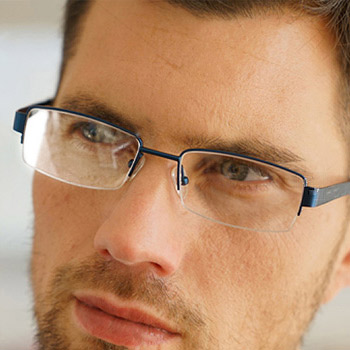Anti-reflective coatings are heavily promoted by eye care practitioners. The coating does just what the name implies, that is, it decreases reflections of bright lights from the surfaces of the lenses. Anti-reflective coatings also increase the light transmission through the lenses. If you are someone who makes public appearances wherein spotlights or other bright lights shine on your face, anti-reflective coatings will make you more photogenic. Be aware that most of the lower-cost anti-reflective coatings make the spectacle lenses difficult to keep clean.
An anti-reflective coating is essential if one does a lot of night driving. One of the most common problems with night driving is Glare, a light source that interferes with your vision, which may slow your reaction time. Night time glare is a result of both bright and dim lights. Although trying to see something in the presence of a light that’s too bright can cause your eyes to squint and become teary, a reduction in the contrast of images brought on by dim lighting can impair your vision as well. The inclusion of an anti-reflective coating will definitely reduce these negative effects.
AR coating is essential when used on high-index lenses, which reflect more light than regular plastic lenses. For example, regular plastic lenses reflect roughly 8 percent of light hitting the lenses, so only 92 percent of available light enters the eye for vision. High index plastic lenses can reflect up to 50 percent more light than regular plastic lenses (approximately 12 percent of available light), so even less light is available to the eye for vision. This is particularly troublesome in low-light conditions Generally, the higher the index of refraction of the lens material, the more light that will be reflected from the surface of the lenses. It also will reduce the effect of halos around lights at night.
The visual benefits of lenses with anti-reflective coating include sharper vision with less glare and greater comfort during prolonged computer use. First prize while working with a computer all day, is an anti-reflective coating with an added blue light control filter. Research has shown this to reduce the fatigue associated with prolonged computer use, which is a reality we are faced with now in any modern office environment.
Anti-reflective coating also is a good idea for sunglasses, because it eliminates glare from sunlight reflecting into your eyes from the back surface of tinted lenses when the sun is behind you. (Generally, AR coating is applied only to the back surface of sunglass lenses because there are no cosmetic or visual benefits to eliminating reflections from the front surface of dark-tinted lenses.)
Most premium AR lenses include a surface treatment that seals the anti-reflective layers and makes the lenses easier to clean. "Hydrophobic" surface treatments repel water, preventing the formation of water spots. Some anti-reflective lenses have surface treatments that are both hydrophobic and "oleophobic" (also called lipophobic), which means they repel both water and oil. These combination treatments typically contain fluorinated materials that give the lenses properties that are very similar to those of nonstick cookware.
Some eyeglass lenses have factory-applied AR coating on both lens surfaces. Other lenses, particularly progressive lenses and other multifocal lenses have the coating applied after the lenses have been customized to your eyeglass prescription by an optical lab.


